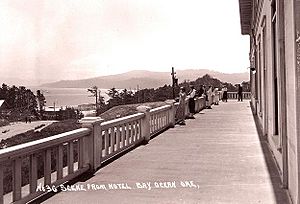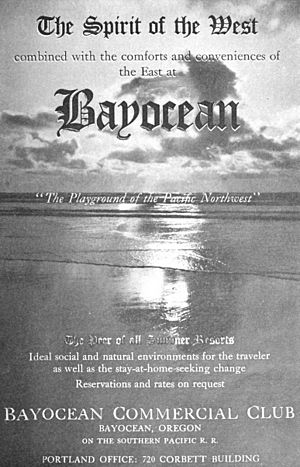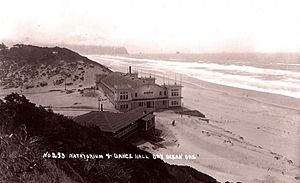Bayocean, Oregon facts for kids
Bayocean was a unique town in Tillamook County, Oregon, United States. It was sometimes called "the town that fell into the sea." This was a special resort town started in 1906. It was built on Tillamook Spit, a narrow piece of land next to Tillamook Bay.
The town grew quickly. Its post office opened in 1909. By 1914, about 2,000 people lived there. But just a few decades later, Bayocean became a ghost town. Many of its buildings were destroyed by coastal erosion. People believe the town's own actions caused this unexpected destruction.
Contents
Building the Dream Town of Bayocean
The idea for Bayocean came from Thomas Irving Potter. He found the spot while exploring the Oregon Coast. His father, Thomas Benton Potter, joined him. They dreamed of creating the "Atlantic City of the West."
They thought the location was perfect. It had amazing views of both Tillamook Bay and the Pacific Ocean. So, they combined "Bay" and "Ocean" to name their new town.
Fun Attractions and Modern Features
Bayocean had many cool things for a small town back then. It had a dance hall and a hotel with an orchestra. There was a movie theater that could seat 1,000 people. The town also had a shooting range, a bowling alley, and tennis courts. It even had its own rail system and four miles of paved streets.
One very special place was a heated natatorium, which is like an indoor swimming pool. It had a wave generator to make artificial waves. There was even a special area for a band to play music for swimmers.
While tourism was key to Bayocean's economy, other businesses existed. These included a cannery, a tin shop, and a machine shop. There was also a Texaco gas station.
Bayocean was very modern for its time. Many towns did not have things like electricity or paved roads. But Bayocean had a water system and a telephone system. It also had its own diesel-powered power plant.
Why Bayocean Disappeared
Even with paved roads, Bayocean was hard to reach. It was not connected to the main road system until the 1920s. Most people arrived by T. B. Potter's steamship, the S.S. Bayocean. The trip from Portland took three days.
The last part of the journey could be scary. The ship had to enter the unprotected mouth of Tillamook Bay. The waves were often very rough. So, Bayocean's residents asked the Army Corps of Engineers for a protective jetty. A jetty is a wall built into the water to block waves.
The Jetty's Unintended Consequences
The Army Corps of Engineers suggested building two jetties. One on each side of the bay's mouth. This would cost about $2.2 million. The town's residents had to pay half. This amount was too expensive for them.
So, Bayocean's citizens asked for just one jetty. It cost a little over $800,000, and the town paid half. The single jetty made entering the bay much smoother. However, this change to the coastline started a big problem. It caused the beaches of Bayocean to erode. The sand slowly washed away, making the beaches narrower. Eventually, the ocean completely covered them.
The Town's Final Years
In 1932, a huge storm hit. Its waves finally crossed the beach and destroyed the large natatorium. More winter storms in 1939, 1942, and 1948 further damaged the land. By 1952, what was left of Bayocean had become an island.
Bayocean's post office closed in 1953. Most of the remaining town was torn down in 1956. This was part of a project to reclaim land and build dikes. In 1960, Bayocean's last house was washed away. The very last building, a garage, fell into the ocean in 1971.
Bayocean's Legacy Today
In the 1970s, a second jetty was built. After this, sand slowly began to build up again on the spit. Today, the area is called Bayocean Peninsula County Park. Almost all signs of the old town are gone. Only a special sign at the south end of the park remembers Bayocean.
A sandy hiking trail, about 7.8 miles long, goes around the peninsula. This trail starts and ends at the park's parking lot. From March through September, hikers must walk on the wet sand of the beach. This is to protect the nesting areas of the snowy plover birds in the dry sand and dunes.




